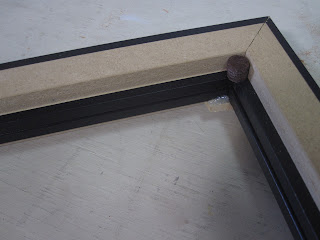March must be my month for varnishing paintings, because a year ago this month,
I wrote here about varnishing.
Well, I'm varnishing again.
Recently, I received a bottle of
Gamvar from Gamblin. Gamvar is no longer, except by special order, available in its previous, concentrated form. Today, you can buy it conveniently premixed with Gamsol and ready to go as a final varnish.
I was excited to try the new Gamvar, because I have gotten tired of the spray cans of varnish I've been using. Once, the spray nozzle got so clogged I couldn't clean it even by soaking it in OMS, and had to throw away a nearly full can. Also, nozzles are notorious for spitting and applying varnish unevenly.
Gamvar requires a brush, and that, of course, requires cleaning, too. But I find cleaning a brush less onerous than trying to clean a clogged nozzle or to get it spraying evenly. Also, less solvent goes into the air, which means fewer toxic fumes.
Gamvar has another benefit. It can also be used as a retouch varnish upon diluting one part Gamvar with five parts Gamsol. This is a real plus, in my mind. I don't have to keep a bottle of retouch varnish handy as well as a bottle of finish varnish. When I'm varnishing, I can bring out all my paintings at once - those needing retouch, and those needing a final varnish. I don't have to split them up into two separate batches.
One important note. If you plan to do more work on the painting, Scott Gellatly, Product Manager of Gamblin, recommends that you use an "oiling out" procedure rather than use Gamvar as a retouch varnish. The reason for this is that the Gamvar is designed to be easily removed with OMS. Any paint applied on top of the Gamvar will also be removed when removing the varnish. If your purpose in applying retouch is to bring up the color for further work on the painting, you should "oil out" instead of using Gamvar. Here's the procedure, from the Gamblin web site:
- Apply a liberal coating of 1:1 Galkyd Painting Medium and Gamsol Odorless Mineral Spirits to a dry painting. This can be applied to the entire painting or just to the area that needs to be enlivened.
- Allow the medium to be absorbed into the painting for approximately two minutes.
- Wipe off the excess painting medium with a soft, lint-free cloth.
- Continue painting.
If the purpose is just to protect the painting while waiting for the final varnish, you'll have no problem with using the Gamvar as retouch.
Gamvar is a great solution for the busy painter. Now if I can just find a way to keep the dog hair out of the varnish.
I have to confess that I've always varnished my paintings reluctantly, mostly because of the bother. But because I paint on a fairly absorbent surface, varnish is vital. Although the plein air pieces look really good when they are glossy and wet, once dry, they die. The darks lighten, reducing contrast, and the colors become duller. Varnishing does wonders - the paintings truly come back to life.
Here's a painting that is unvarnished on the left half but has had Gamvar applied to the right. The arrow marks the line between them.














































